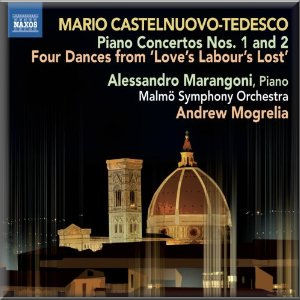 |
 |
|


alternatively
CD: MDT
AmazonUK
AmazonUS
Sound
Samples & Downloads |
Mario CASTELNUOVO-TEDESCO (1895-1968)
Piano Concerto No. 1 in G minor, Op. 46 (1927) [29:12]
Piano Concerto No. 2 in F major, Op. 92 (1936/37) [31:15]
Four Dances from Love’s Labour’s Lost, Op. 167
(1953) [16:16]
 Alessandro Marangoni (piano)
Alessandro Marangoni (piano)
Malmö Symphony Orchestra/Andrew Mogrelia
rec. Concert Hall of the Malmö Symphony Orchestra, Malmö,
Sweden, 23-27 May 2011
 NAXOS 8.572823 [76:43]
NAXOS 8.572823 [76:43]
|
|
|
The Naxos 20th Century Italian Classics series stutters
on and Castelnuovo-Tedesco is featured now for the third time.
His Shakespeare obsession does not retreat. There are two volumes
available of his Shakespeare Overtures (8.572500
and 8.572501).
In fact I reviewed one of them in February 2011. There are also
two Shakespeare operas including All’s Well that Ends
Well not to mention 35 sonnets and all of the available
poems.
While the major works here are the two piano concertos the charming
Four Dances from Love’s Labour’s Lost immediately
took my fancy. This recording also constitutes their first performance.
Conductor Alessandro Marangoni who has also written briefly
about this in the booklet notes has resuscitated the score.
There are four movements, which certainly make no attempt to
be quasi-Elizabethan, you may be glad to hear. It’s something
which English composers often did, normally sending us off into
the embarrassed corner. We do have a Sarabande and a
Gavotte for each of the King of Navarre and the Princess
of France. There is also a Spanish Dance for the comical
Don Adriano: witty music but not quite capturing the full benefit
of his character. Finally there’s a jaunty Russian
Dance for the Masque, which is the comical climax to the
play in Act V. It’s wonderful that this colourful score
has been dug up. I for one, especially enjoyed it.
I would like to describe the Piano Concerto No. 1 as gay
but I have a feeling that although it describes perfectly this
happy work I should use the word jaunty. It is in three
movements and both of the outer ones are full of bravura, excitable
rhythms and colourful orchestration. The third is something
approaching a tarantella at times. The nicely detailed booklet
notes by Graham Woods talk of “good-humoured vigour”
which is much better than my words but there are also lyrical
tendencies. There’s a lovely cello solo in the first movement
and in the central section of the third. The movement that really
caught my fancy was the middle Andantino alla Romanza.
The opening tune is almost folk-like, a sort of Mediterranean
version of a Rachmaninov romantic melody found in his last two
concertos. Whereas the Russian tends towards dark passion Castelnuovo-Tedesco
is more song-like, simple and sunlit. I was delighted to make
the acquaintance of this work although for 1927 it must have
seemed a little anachronistic. The performance is all you might
want and the recording excellent and immediate.
I’m sorry to say that I haven’t particularly taken
to the Piano Concerto No. 2. On the other hand, it may not be
exactly the work that the composer intended. It seems that the
plates and the original materials were lost in the Florence
floods of 1966 but a score of sorts had been placed in America.
Even so, some reconstruction has proven necessary. This has
been done by Marangoni who says in his brief note that he wishes
to thank the “composer’s daughter for loaning me
the manuscript”.
The work is in three movements with a Romanza second.
The opening seems to come out of rather weak Tchaikovsky. The
whole movement feels over-indulgent in its out-dated romanticism.
The second subject, when played by the piano, will remind you
of Rachmaninov in Mediterranean mood. The Romanza lurches
around and has little character. It’s not until the finale,
Vivo e impetuoso, that something genuinely personal seems
to emerge. It spins interestingly out of the Romanza
and skips along à la Litolff. The piano is, throughout,
more integrated with the orchestra than in the First Concerto
although there is a fine cadenza. It may be that I am being
a bit harsh or that I am out of sorts with this piece however
I do like the finale. All that said, I’m not at all sure
that if I shall return to it that often.
More sympathetically I must add that the Swedish orchestra play
as if they have been familiar with this music for years. They
are aided by Marangoni’s scholarship to say nothing of
the background work and enthusiasm of Andrew Mogrelia. The recording
is good standard Naxos house-sound. If you fancy piano concerto
by-ways then at Naxos prices you can’t go far wrong.
Gary Higginson
|
|

